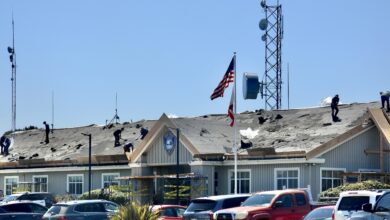NOAA effort pushes more ocean fish farming
The Obama administration has launched an effort to increase fish farming in the nation”s oceans, as a way of creating jobs and reducing a $9 billion seafood trade deficit. The new Department of Commerce and National Oceanic and Atmospheric Administration (NOAA) aquaculture policy would make it easier to create open ocean fish farming off Mendocino. But the action is being taken mostly to help create large-scale aquaculture in the Gulf of Mexico.
Also, a major expansion of already substantial shellfish farming in Puget Sound and areas of the Atlantic is foreseen by aqua-corporations and NOAA.
Shellfish farmers in both Marin and Humboldt counties hope the new plan can save industries they say are unable to compete on the world stage because of confusing and incomplete U.S. regulations.
Fish farming, or aquaculture, which recently surpassed fishing for wild stocks as the world”s prime source of seafood, has been opposed locally by both the fishing industry and environmentalists.
The Gulf of Mexico Fisheries Management Council in 2009 established the nation”s first ever comprehensive fish farming plan to cover state and federal waters. But no regulatory structure was in place to allow it — until now.
Locally, the Pacific Coast Fishery Management Council (PFMC) has not considered doing a similar plan for California, Michael Rubino, the manager of NOAA”s aquaculture program said. However, the Council governing Hawaiian waters is interested and working on a plan, he said.
Currently, there are no aquaculture operations anywhere in federal waters. The new plan could bring half a dozen large-scale fish farms into the Gulf in a year or more, according to an account in the New Orleans Times-Picayune.
While the Obama administration is promising that sustainability and environmental protection will be emphasized, the president is following rather closely on a favorite idea of former President George Bush, who vigorously promoted fish farming in the years immediately after being elected in 2000.
Environmental groups are very critical of the new Obama administration plan, while business groups say it is a good start.
“We do not see how such a far-reaching policy can be implemented to protect our public resources when adverse impacts of industrial aquaculture are ignored,” a Sierra Club comment on the plan states. “NOAA continues to state they recognize the importance of science, yet it is apparent that substantial scientific assessment of impacts and risks has not been conducted.”
The NOAA plan promotes free trade and removal of trade barriers so American companies can better compete on the world stage as key to awakening the aquaculture industry in the United States. Rubino could not explain what trade barriers currently exist that are slowing U.S aquaculture.
Worldwide fish farming is controlled by large corporations from the Pacific Rim, Norway and even South Africa. Many South American fish farms are owned by these concerns.
With new fish farms are likely to be proposed by global conglomerates, could locals expect anything more than minimum wage jobs from an offshore fish farm?
Rubino rebuffed the idea that foreign corporations would dominate the industry here to the extent they have in other ends of the world. With fishermen often opposed, he said the people working to create fish farming in the United States are often from old fishing families.
“In a way, these people have the social capital to do it,” Rubino said.
There were 270 comments filed on the aquaculture proposal when it opened for public input earlier this year. Although there were numerous comments from the Bay Area, Santa Rosa, Humboldt, Sonoma and Marin counties, as well as many members of Congress, there were no comments filed by Mendocino County residents or government representatives.
Donald Hull, CEO of the Humboldt Bay Harbor Recreation and Conservation District, described how 325 acres of shellfish aquaculture employs 56 people in the Eureka area, involving almost entirely family-run businesses. Humboldt Bay has 4,000 acres of certified aquaculture growing area. The production was once more than three times larger. Modern expansion is held back chiefly by the high costs of getting state and federal approvals and the confusing nature of the process, Hull said.
Hull commended the effort to streamline the process but said state and local officials would need to be at the table to create a “one stop” shopping permitting process.
Rubino agreed a central permitting agency process is needed and said the new process is the first step.
Commercial abalone and mussel aquaculture was proposed off Fort Bragg in the 1980s and 1990s, but came to nothing. Unlike the shallow Gulf, federal waters off Northern California are likely too deep and windy to support caged fish farms.
Fish farming has a sordid history of allowing disease to spread to wild populations.
With all abalone harvesting and most abalone eliminated in Southern California, corporate abalone farms blossomed. There, an abalone parasite, sabellid polychaete, was imported from global farming operations in South Africa. The worm, which slows growth and makes shells brittle, spread to abalone farms all over California, along with many public aquariums and even study facilities, according to numerous scientific studies found online. At one point, the worm escaped into the wild in Southern California through an abalone farm”s outfall.
In 2007, the outbreak of infectious anemia in salmon closed down many fish farms in Chile and created worries about the native population.
Rubino said the new effort would benefit from “20 years of lessons learned.”
Rubino said with the creation of solid new federal standards and the promotion of a vigorous U.S industry, the government will be in a better position to insist on the kind of health and environmental standards that Americans want. Foreign aquaculture now accounts for about half of the 84 percent of seafood imported by the U.S., a NOAA press release stated.
The new policies impact all commercial aquaculture from backyard pond fish farms to large-scale operations in state and federal ocean waters. Salmon hatcheries are also considered part of aquaculture, but no big changes are being made to hatchery regulations, Rubino said.
The domestic aquaculture industry (both freshwater and marine) currently supplies about 5 percent of the seafood consumed in the U.S. The cultivation of shellfish, such as oysters, clams, and mussels, comprises about two-thirds of U.S. marine aquaculture production. Salmon and shrimp aquaculture contribute about 25 percent and 10 percent, respectively.
Rubino cited studies that show the wild stock, even with successful rebuilding efforts, cannot meet the increasing American demand for seafood, as well as federal health recommendations that people eat two, rather than one fish meal per week.
Among those to comment was Donald Shregardus, deputy assistant secretary of the U.S. Navy, who criticized the new plan for not identifying many uses of the ocean, including military and suggesting how coordination could be better, so that conflicts with ships and planes can be avoided.
Although nobody locally commented officially, there were some responses to the newspaper”s listserv inquiry.
Bernie MacDonald said the fact that free trade increases production doesn”t make it good for the ocean.
“Very efficient, but murder on the ocean. Scares me — we gotta go local, quickly,” MacDonald said.
The policies and public comments can all be seen on the NOAA website at http://www.nmfs.noaa.gov/aquaculture/policy2/.
Email Frank Hartzell at frankhartzell@gmail.com.




